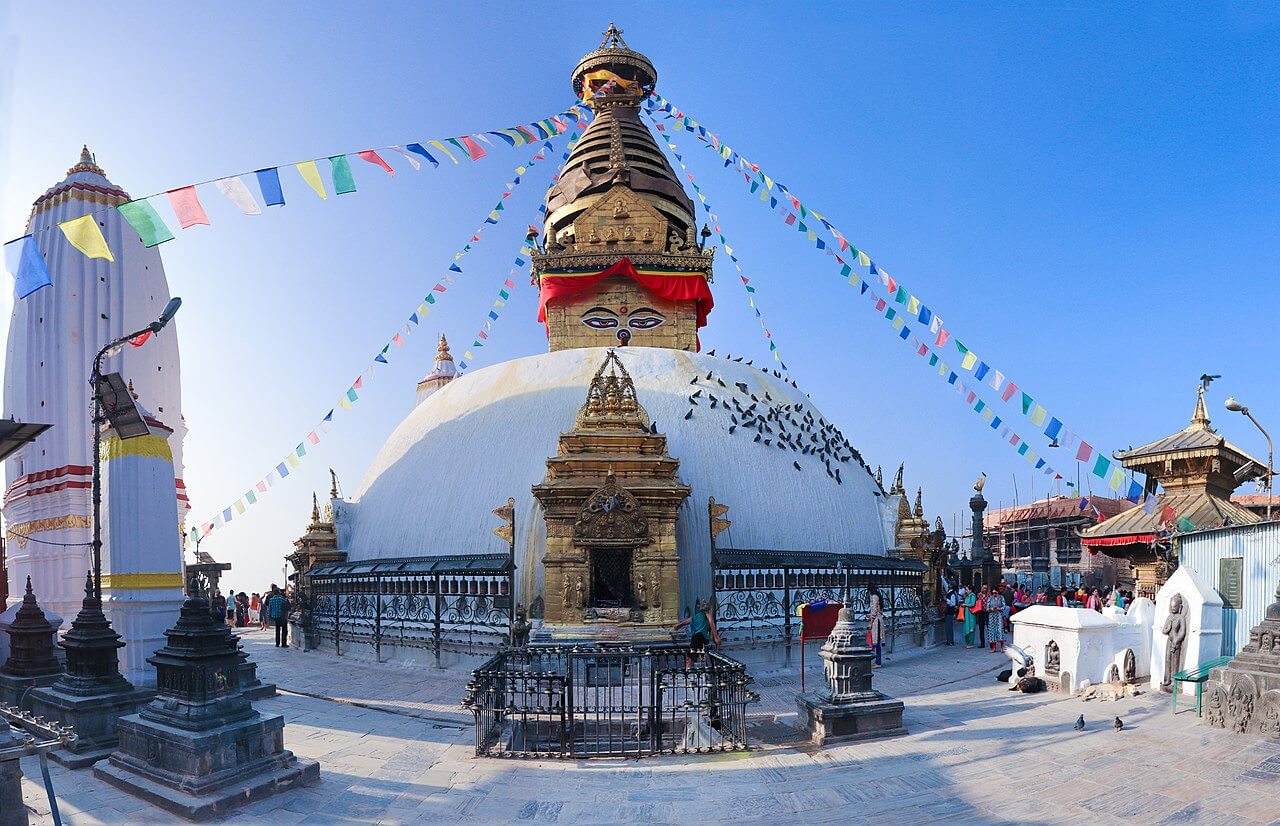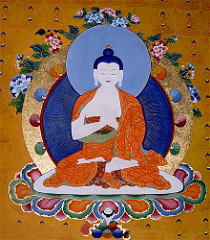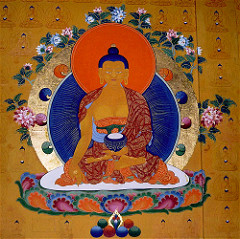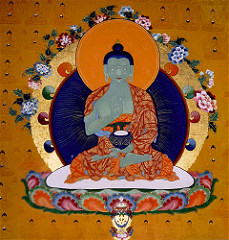Swayambhu Stupa
Swayambhu Stupa (Monkey Temple) is the only stupa in the whole Buddhist world with its unique characteristics and is believed to have originated itself as the name itself in Sanskrit refers (Swayam – On itself) and (Bhu – came into Existence). This name is further supported by the literary sources of the greatest and ancient literature known as Swayambhu Purana which also links to the formation of the Kathmandu valley after the draining of water and turning into a populated space by Manjushri Bodhisattva.
Swayambhu stupa is important in many ways, but here in this issue related to iconographic features of Pancha Dhyani Buddhas, it is very important to elaborate because this is the only shrine where all five Celestial Buddhas are represented. Their icons are placed in the niches of the stupa in four different directions. Even the Vairochana Buddha is represented in the South Eastern Part of the Stupa in between Akshovya and Ratnasambhava. In all other stupas, Vairochana Buddha is not shown in the iconographic image but is represented to be in the dome inside the stupa, but in Swayambhu, it is uniquely installed and represented in perfect arrangement.
Five Dhyani Buddhas
The Five Dhyani Buddhas, or Pancha Buddha or Five Tathagatas or Great Buddhas of Wisdom, are the central features of Vajrayana Buddhism including Nepal and Tibet and the art and architecture of this region. They are often found in Tibetan mandalas and thangkas. Each Buddha is believed to be capable of overcoming a particular evil with a particular good, and each has a complete system of 4 iconographic symbolism. They are believed to represent the five great moments in the life of Buddha, the five typical elements of Indian philosophy or the five directions. However, the most important attribute that esoteric Buddhism places upon this set of five Buddhas are their ability to transform the five great human delusions into specific positive attributes. The five Dhyani Buddhas are:
-
- Vairocana (Sanskrit: वैरोचन)
- Akshobhya (Sanskrit: अक्षोभ्य)
- Ratnasambhava (Sanskrit: रत्नसम्भव)
- Amitabha (Sanskrit: अमिताभ)
- Amogasiddhi (Sanskrit: अमोघसिद्धी)
Vajrayana introduced the theory of the five Dhyani Buddhas as embodiments of the five cosmic elements– ether, water, earth, fire and air and formulated the theory of the family of the five Dhyani Buddhas from which deities emanate according to need. The cult of the Dhyani Buddhas, who are assigned definite positions in the cosmogony of the stupa is quite popular in Nepal and may have been introduced from India as early as the 7th century A.D. The immense popularity of this cult can easily be seen and the hundreds of votive chaityas in and around the Valley. Of the five Dhyani Buddhas the senior, in Nepali hierarchy, is Vairochana (ether) who occupies the centre of a Mandala but is not represented in the roadside votives which depict only the other four Dhyani Buddhas, Akshobhya (water) of the East, Ratna-Sambhava (earth) of the South, Amitabha (fire) of the West and Amoghsiddhi (air) of the North. In the Swayambhu stupa, Vairochana is placed between Akshobhya and Ratna-Sambhava. Their female counters are placed between them.


According to this statement, Swayambhu stupa has multiple symbolism and the present iconography of the stupa is the iteration of an early version that goes back at least to the sixth century A.D. Nowhere in his work Huntington suggests that earlier symbolism of the stupa might be different from later interpretations. He believes that the deities of the shrines around the stupa are arranged in accordance with the Pindikrama sadhana of the Guhyasamaja Tantra. He writes:
… it can be seen that the Vairocana shrine is just to the South of Akshobhya’s. In this meditation, the practitioner visualizes himself at the east as Akshobhya in non-dual state with Sparshavajri/Mamaki. In the completion stage, the practitioner as Akshobhya/Sparshavajri is in the centre of the mandala and looks to the east to realize that Vairochana is present in no-dual state with Saptalochana, who is represented in the northeast shrine. Thus, for part of the meditation, Vairochana is actually on the east and his shrine is appropriately physically located there on the Mahachaitya.
His argument that the iconography of the stupa is in perfect harmony krama Sadhana with the Pin Guhyasamajatantra is mainly based on the location of the Vairocana shrine at the eastern section of the Svayambhu Stupa. But this shrine did not exist there before 1713 AD. The Swayambhu Purana, most of which was written around the time of King Abhaya Malla‘s rule (ca. 1428-1482), refers to only four Buddhas: Akshovya, Ratnasambhava, Amitabha, and Amoghasiddhi at four directions of the stupa. Since Vairocana was considered to be in the middle of the stupa, his shrine was not represented then outside the dome of the stupa. According to contemporaneous diaries known to the Newars as Thyasaphu the earliest image of Vairocana at the eastern section of the stupa is the contribution of the queen mother Bhuvanalakskshmi active during the first quarter of the 18th century. Almost exactly a hundred years later, the Newar Buddhists of Kathmandu replaced the original contribution of the queen with a much bigger statue of the god when they renovated the stupa in 1816. However, the image of Vairocana that we see today is of even more recent date. According to the pedestal inscription, the image was erected only in 1918.
1. Vairocana Buddha (Sanskrit: वैरोचन)
Vairocana Buddha is one of the Five Tathagatas symbolizing all-pervasive wisdom (Suvisuddha dharma dhatu jnana) i.e. knowledge free from all kinds of obscuration. Vairocana Buddha is placed generally in the sanctum of the stupa. But Vairocana Buddha in Swoyambhu is placed between Akshobhya and Ratna Sambhava. Vairocana Buddha always resides in the Akanistha heaven that is the centre of the stupa.
Vairocana Buddha is white in colour and his hands are held against his chest with the tips of thumb and forefinger of each hand joined displaying Bodhyanga Vehicle mudra known as Dharmachakraparvartana Mudra. The vehicle of Vairocana Buddha is a pair of lions symbolizing lions roar of Dharmadhatu jnana terrifying all wrong views. The female consort of Vairochana Buddha is Vajradhatvishwori. She is represented in the centre of the Vajra Mandala as the eliminating and as powerful as Thunderbolt.
Vairocana Buddha originates from the seed syllable “Om” placed on the orb of the moon. He also represents Rupa (form) of the five aggregates.

2. Akshobhya Buddha (Sanskrit: अक्षोभ्य)
Akshobhya Buddha is one of the Pancha Buddhas symbolizing Mirror-like Wisdom (Akasha jnana), which means the wisdom like space, all-pervasive, without periphery and without characteristics. Akshobhya Buddha is the essence of a purified form of Hatred. The image of Akshobhya Buddha is always placed in the East in all stupas, including Swayambhu.
Akshobhya Buddha is blue in colour. Akshobhya Buddha exhibits Earth-touching gesture known as Bhu Sparsa Mudra. Akshobhya Buddha rides on the throne of an elephant symbolizing steadfast nature of his Bodhisattva vows.
The female consort of Akshobhya Buddha is Lochani, who is believed to illuminate all three Lokas:
Svarga, Martya and Patala.

3. Ratnasambhava Buddha (Sanskrit: रत्नसम्भव)
Ratna Sambhava Buddha (Buddha born from Jewel) is one of the Pancha Dhyani Buddhas symbolizing the wisdom of equality (Samatajnana). According to the commentary of Namasangiti, the author Ravisri says,
“All the phenomena is devoid of essence lacks true inherent existence and hence is dream like or illusion or is empty”. Thus the knowledge of essencelessness of persons and the phenomena is the wisdom of equality: Buddha Ratnasambhava is the personification of this wisdom in Vajrayana Buddhism.
Ratna Sambhava Buddha is yellow in colour. Ratna Sambhava Buddha belongs to the Buddha family of Jewel or boon; therefore, his posture is like boon giving known as Varada Mudra with his right hand. Ratna Sambhava Buddha holds Cintamani jewel in his left hand kept on his lap. Ratna Sambhava Buddha is placed in the stupa facing to the South. Ratna Sambhava Buddha also represents the purified form of defilement pride. Ratna Sambhava Buddha rides on the horse throne symbolizing that he ferries over the suffering sentient beings with full vigour. He resides in the pure abode of Ratnavati heaven. The female consort of Ratna Sambhava is Mamaki who is gifted with the sense of smelling of Nose and is all illuminating and loved by all.

4. Amitabha Buddha (Sanskrit: अमिताभ)
Amitabha Buddha (Purified from desire), meaning immeasurable light or limitless light, is one of the Pancha Dhyani Buddhas representing the wisdom of discriminating awareness (Pratyavekshanajnana). When discriminating wisdom dawns on us, we realize Non-production or non-origination of all beings and thus, Amitabha Buddha represents that purified form of desire.
Amitabha Buddha is red in colour. Amitabha Buddha is represented in the stupa facing to the west. Amitabha Buddha rides on peacock symbolizing that he can take away the suffering of others just as the peacock eats poisonous plants and yet his tail shines forth. Amitabha Buddha resides in the western land of unlimited bliss (Sukhavati). Amitabha Buddha is assisted by two bodhisattvas viz. Avalokiteshvara and Mahasthamprapta.
Amitabha Buddha always exhibits Dhyana Mudra. Amitabha Buddha belongs to the Lotus family. Amitabha Buddha originates from the seed syllable hrīḥ. The female consort of Amitabha Buddha is Pandura, who is gifted with the sense of taste through Tongue. She is the fourth of the Tara family.

5. Amoghsiddhi Buddha (Sanskrit: अमोघसिद्धी)
Amoghsiddhi Buddha (the purified form of jealousy) is one of the Pancha Dhyani Buddhas. Amogh Siddhi Buddha represents the ‘all accomplishing wisdom’ (Krityanusthan jnana). Amoghsiddhi Buddha represents the purified form of jealousy.
Amoghsiddhi Buddha is green in colour. Amoghsiddhi Buddha is represented in the stupa facing to the north. Amoghsiddhi Buddha rides on Garuda symbolizing that he can detect the presence of serpent-like delusion from a distance. A serpent with seven hoods and an umbrella is depicted on the background. He exhibits Abhaya Mudra symbolizing fearlessness. Amoghsiddhi Buddha alone has a canopy of snakes over his head. He is said to be the embodiment of volition (Sanskara) and Air element (Vayu). The female consort of Amoghasiddhi Buddha is Mahadevi Tara (Arya Tara) who is capable of liberating all the sentient beings from this ocean of the material world.

(All 5 Dhyani Buddhas, Photo credit: Maren Yumi Motomura)
Summary of Five Dhyani Buddhas or Pancha Dhyani Buddhas
| Family | Buddha | Vajra | Ratna | Padma | Karma |
|---|---|---|---|---|---|
| Direction | centre | east | south | west | north |
| Colour | blue | white | yellow | red | green |
| Family Symbol | eight-spoked wheel | vajra | jewel | lotus | double vajra or sword |
| Masculine Buddha | Vairochana | Akshobhya | Ratnasambhava | Amitabha | Amoghasiddhi |
| Wisdom | wisdom of dharmadhatu | mirror-like wisdom | wisdom of equality | wisdom of discernment | all-accomplishing wisdom |
| Poison | delusion or ignorance | anger | pride | desire | jealousy |
| Skhanda | form | consciousness | feeling | perception | formations |
| Feminine Buddha | Dhatvishvari | Buddhalochana or Mamaki | Mamaki or Lochana | Pandaravasini | Samayatara |
| Element | space | water | earth | fire | air |



